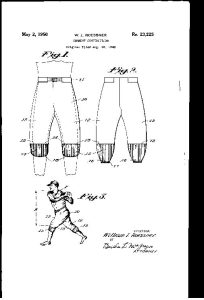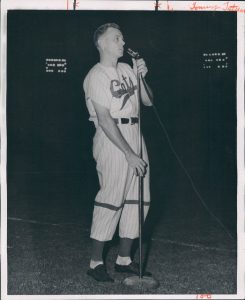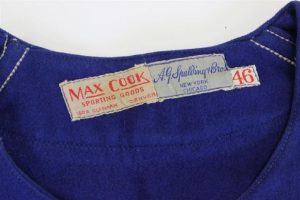It seemed simple enough back in 1972 when I was told “the strike zone is between your arm pits and your knees.” I found this a bit more insightful than also being informed to “keep your eye on the ball.” Truth be told, I may have closed my eyes a time or two while facing a 20 mph heater that sailed up and in, but when you’re eight years old… anything the big kids tell you about the game is gospel.
The Strike Zone
1996 – The Strike Zone is expanded on the lower end, moving from the top of the knees to the bottom of the knees.
1988 – “The Strike Zone is that area over home plate the upper limit of which is a horizontal line at the midpoint between the top of the shoulders and the top of the uniform pants, and the lower level is a line at the top of the knees. The Strike Zone shall be determined from the batter’s stance as the batter is prepared to swing at a pitched ball.”
1969 – “The Strike Zone is that space over home plate which is between the batter’s armpits and the top of his knees when he assumes a natural stance. The umpire shall determine the Strike Zone according to the batter’s usual stance when he swings at a pitch.”
1963 – “The Strike Zone is that space over home plate which is between the top of the batter’s shoulders and his knees when he assumes his natural stance. The umpire shall determine the Strike Zone according to the batter’s usual stance when he swings at a pitch.”
1950 – “The Strike Zone is that space over home plate which is between the batter’s armpits and the top of his knees when he assumes his natural stance.”
1907 – “A fairly delivered ball is a ball pitched or thrown to the bat by the pitcher while standing in his position and facing the batsman that passes over any portion of the home base, before touching the ground, not lower than the batsman’s knee, nor higher than his shoulder. For every such fairly delivered ball, the umpire shall call one strike.”
It appears that the strike zone I grew up with became an official part of the big game back in 1950…arms pits to the top of the knees. But did we really need a uniform to tell us this? Apparently someone thought it was a good idea, and an idea that at times attributed to being the brain child of Branch Rickey. However, when these uniforms were introduced by the Denver Bears mid-season of 1952, credit was given a Denver native then identified as “Bill Roessman” who is said to have come up with idea around 1950. Actually the name and the date cited in 1952 was bit off as confirmed by a Patent filling from 18 August 1948 (Patent Publication date; 2 May 1950)

I found it interesting that this Patent by William Roessner (Denver, Colorado) coincided with the change in the upper range of the strike zone from the shoulders to the arm pits, although Roessner’s effort only involved the pants. While these Bears uniforms were certainly unique, they were not the first attempt to visually indicate the strike zone on the batter. According to an article that appeared in The Sporting News on July 2nd, 1952 “Several years ago the Ft Worth (Texas) Club tried a similar experiment, using horizontal black bands on the uniform to designate the limits of the strike zone.” This experiment took place on August 19th of 1950. It lasted all of one game in a contest between the Ft. Worth Cats (Brooklyn AA Affiliate) the Oklahoma City Indians (Cleveland AA Affiliate) and it reflected the change in the strike zone that took effect that year.

The Bears uniforms were not an immediate hit with the Denver players. A number of them complained that the outfits looked too much like softball uniforms. From a functional standpoint, the players were not fans of the additional layer of blue fabric in the knees, citing it as being uncomfortable. The feedback from the man behind the plate was a little more positive. According to Western League umpire Bob Phillips who worked the plate for the first game of the July 4th twin bill said “I thought it provided definite help in calling the low pitches, but I wasn’t conscious of any help on the high pitches. Players seem to crouch and bob around too much for the uniform to help with the pitch around the armpit.”
These Denver Bears “Strike Zone Uniforms” were only produced in white home versions. No road “strike zone uniforms” were manufactured by Spalding (distributed by Max Cook Sporting Goods, Denver, Colorado).

To be more specific the uniforms were provided by a collection of local Denver businessmen who formed a corporation called “The Strike Zone Uniforms Estate” in hopes the idea would catch on in a big way. Bob Howsam, then President and General Manager of the Bears said that before he would make a decision on their continued use for the 1953 season, he wanted to make sure the uniforms were given a thorough evaluation. As such, special permission from the other clubs of the Western league was obtained by Executive Vice President-Secretary Harold George for the Denver Bears to wear their novel “Strike Zone” uniforms for select away games on their eastern road trip which began July 24th of 1952. While worn on the road through portions of the remainder of the 1952 season, “The Strike Zone Uniforms” were worn only once at home by the Bears (4 July 1952).
The 1952 Denver Bears ended the season as champions of the Western League. Bob Howsam was named Minor League Executive of Year by The Sporting News, but alas these colorful and interesting “Strike Zone Uniforms” were regrettably called out looking… looking mighty fine I might add.
Dave Grob
davegrob1@aol.com
.
[

